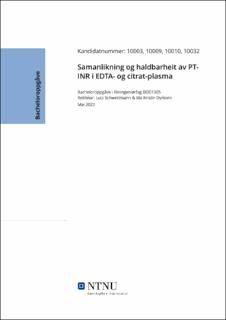Samanlikning og haldbarheit av PT-INR i EDTA- og citrat-plasma
Bachelor thesis
Permanent lenke
https://hdl.handle.net/11250/3005245Utgivelsesdato
2022Metadata
Vis full innførselSamlinger
Sammendrag
Samandrag
Føremålet med oppgåva var å undersøke om EDTA-plasma kan nyttast alternativt til citrat-plasma ved måling av PT-INR, samt verifisere haldbarheita til prøvemateriala i romtemperatur og ved 2-8 ℃. Det blei utført ein studie med to ulike problemstillingar. Den første tek for seg ei metodesamanlikning for å finne ut om det er ein signifikant ulikheit i PT-INR analysert i EDTA- og citrat-plasma. Den andre omhandlar ein haldbarheitsundersøking for å verifisere haldbarheita til PT-INR i EDTA- og citrat-plasma oppbevart i ulik temperatur.
Til samanlikningundersøkinga var det totalt 57 deltakarar, der det blei samla inn eit citrat-røyr og eit EDTA-røyr frå kvar deltakar. Prøvemateriala blei sentrifugert og analysert fortløpande etter innsamling. Til haldbarheitsundersøkinga var det totalt 33 deltakarar. Frå kvar deltakar blei det samla inn to citrat-røyr og eit EDTA-røyr. Prøvane vart analysert ved fem ulike tidspunkt (1, 5, 8, 12 og 24 timar) etter prøvetaking. Til begge problemstillingane deltok pasientar som blei behandla med antikoagulerande medikament, samt deltakarar med INR i normalområde. Til innsamling og analysering av prøvemateriala blei det nytta batch-metoden. I denne studien blei det brukt Sysmex CS-5100 til analysering av prøvane. Statistiske metodar legg grunnlag for å vurdere resultata.
Metodesamanlikninga viste ikkje ein statistisk signifikant forskjell av INR i EDTA- og citrat-plasma. Den gjennomsnittlege differansen er 0,0693. Resultata frå samanlikninga viste at EDTA-plasma kunne nyttast alternativt til citrat-plasma ved analysering av PT-INR. Haldbarheitsundersøkinga viste at PT-INR i citrat- og EDTA-plasma oppbevart i romtemperatur er haldbart opp til 24 timar. Citrat-plasma lagra ved 2-8 ℃ er haldbart opp til 12 timar, medan EDTA-plasma oppbevart ved same temperatur er haldbart opp til 8 timar. Resultata viste dermed at prøvemateriala hadde betre haldbarheit oppbevart i romtemperatur, kontra oppbevaring ved 2-8 ℃. Abstract
The purpose of this study was to examine if EDTA-plasma can be used as an alternative to citrate-plasma when measuring PT-INR, as well as to verify the stability of the sample material stored in room temperature and 2-8 ℃. The study included two research questions concerning PT-INR. For the first research question we did a method comparison to see if there were any significant differences in PT-INR analyzed in EDTA- and citrate-plasma. The second research question concerns the stability of PT-INR in EDTA- and citrate-plasma stored in different temperatures.
For the method comparison there were 57 participants in total. To compare the difference between PT-INR in EDTA- and citrate-plasma, one citrate-tube and one EDTA-tube were collected from each participant. The test tubes were centrifuged and analyzed within an hour of sampling. For the stability question there were 33 participants, where two citrate-tubes and one EDTA-tube were collected per person. The plasma were analyzed in five intervals (1, 5, 8, 12 and 24 hours). People with normal and abnormal INR were included for both research questions. The batch-method was used to collect and analyze the sample material. The instrument used in this study was Sysmex CS-5100. Statistical methods were used to evaluate the data collected from the study.
The results from the method comparison showed that there were no statistically significant differences between PT-INR in EDTA- and citrate-plasma. The average difference is 0,0693. The results showed that EDTA-plasma could be used as an alternative for measuring INR. The stability results showed that PT-INR in citrate- and EDTA-plasma stored at room temperature were stable up to 24 hours. PT-INR in citrate-plasma stored at 2-8 ℃ were stable up to 12 hours, and EDTA-plasma stored at the same temperature were stable up to 8 hours.
